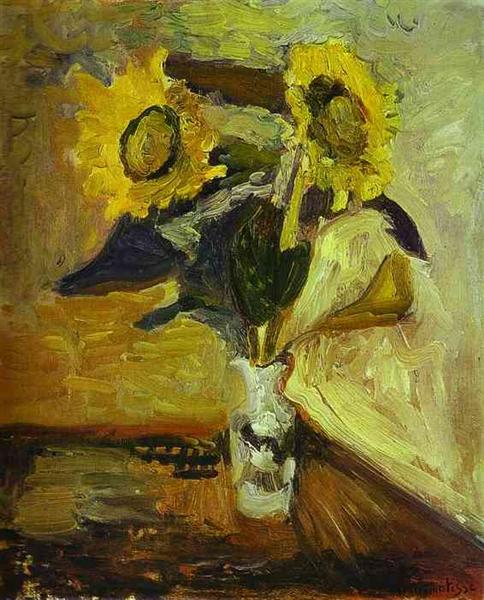Description
The study of Henri Matisse's work takes us on a journey through color and form, a traverse where intensity and simplicity coexist in a masterful way. "Vase of Sunflowers" (1898), a piece measuring 49x60 cm, is an early example of his experimental talent and his quest to capture the essence of nature through painting.
The first impression one gets when observing "Vase of Sunflowers" is a feeling of warmth and vitality. Matisse has chosen to represent sunflowers, flowers that by their very nature symbolize energy and life, standing out against a sober background. The interesting thing is how these flowers almost seem to overflow from the vase that contains them, a vase that, at first glance, might be perceived as rudimentary but that helps focus the viewer's attention on the sunflowers themselves. The choice of a simple vase and the configuration of the space suggest a deliberate intention by Matisse not to distract the eye from the vibrant burst of color and form represented by the flowers.
As for color, the golden tones of the sunflowers harmoniously contrast with the green of the stems and the vase, creating a balanced and pleasing composition to the eye. Matisse's technique in this work, though still in its early stages compared to his later production, already hints at his concern for chromaticism and his desire to explore emotions through colors. Matisse's brushstroke in this painting is expressive, almost gestural, and although it is not the loose and uninhibited approach that characterizes his later works, one senses a freedom and an incessant search for personal expression.
The background of "Vase of Sunflowers" is as important as the subject itself. In 1898, Matisse was in a transitional period in his career, influenced by post-impressionism and especially by the work of Van Gogh, another master of color and the representation of sunflowers. Matisse carefully studied the techniques of his predecessors, and in this work, one can notice a subtle confluence of the vibrant use of color by the post-impressionists with a composition that begins to flirt with the avant-garde and the principles that would later lead to Fauvism.
Furthermore, it is fascinating to think about how "Vase of Sunflowers" fits into Matisse's entire body of work. This piece, with all its intensity and subtlety at the same time, seems to announce the arrival of an artist who would redefine the relationship between form and color in contemporary art. Matisse is not content with imitating nature; he transforms it, reinvents it, and presents it to the viewer in a new light. In this sense, "Vase of Sunflowers" is a testament to Matisse's ability to look beyond the obvious and find a personal language in the representation of the mundane.
Through "Vase of Sunflowers", we can glimpse the seed of what would become one of the most energetic and revolutionary movements in modern art: Fauvism. Although this work does not fully dive into the turbulent waters of that style, it is impossible not to see in it the sprouts of a new way of seeing the world. The palette of vibrant colors, the strength in the brushstroke, and the simplification of forms are elements that Matisse would continue to explore more deeply in the years to come.
Ultimately, "Vase of Sunflowers" is a piece rich in meaning and visual beauty. It is a work in which Matisse invites us to contemplate the power and simplicity of color, form, and nature. This work is not only an early demonstration of the artist's talent but also a statement of intent, a glimpse of the path he would follow that would establish him as one of the most important figures in 20th-century art.

